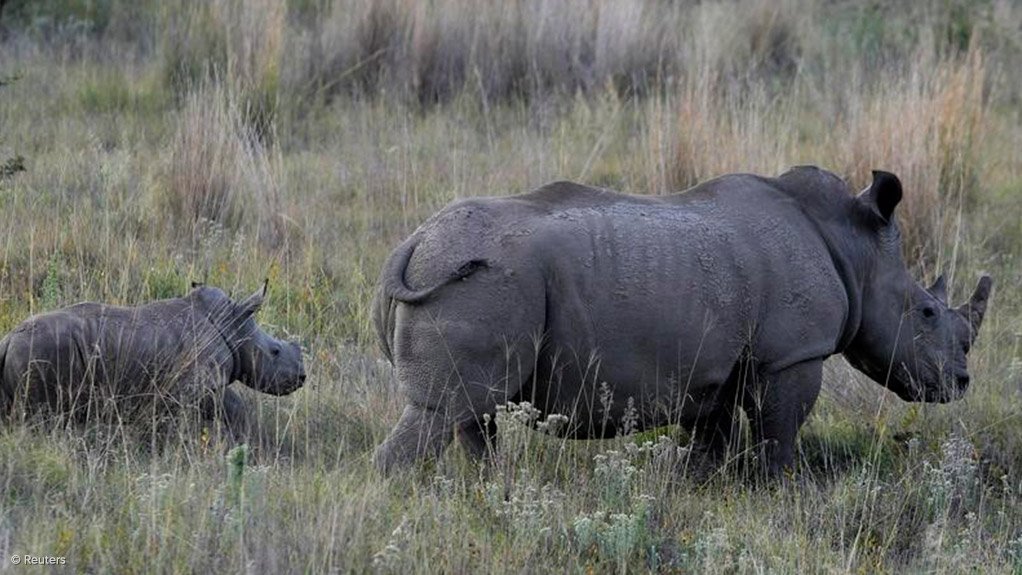For the first time in a decade, rhino poaching levels have stabilised, despite escalating poaching pressure and increased poaching activity in protected areas.
This was according to Minister of Environmental Affairs Edna Molewa, who addressed the media in Pretoria on Thursday on the progress of government’s efforts in combating rhino poaching in South Africa.
She revealed that 1 175 rhino were poached by the end of December 2015 – of which 826 were in the Kruger National Park – an improvement from the 1 215 that were poached in 2014. However, she added that the onslaught against rhino poaching continued unabated.
Government, the private sector, communities and civil society had stepped up efforts and improved their strategies – which had delivered a number of satisfying results over the last year, said Molewa.
During 2015, 317 people were arrested for rhino poaching offences, of which 202 were arrested in the Kruger National Park and 115 in the area adjacent to the park.
“By the end of 2015, all rhino poaching crime scenes in the Kruger National Park have been attended to in accordance with standard protocols. If one considers the backlog we faced in 2014 and 2015, this is a remarkable achievement,” the Minister stated.
The United Nations Environment Programme’s Global Environment Facility provided $2.7-million in funding for forensic mobile crime scene units, which were used in crime scene management in outlying areas.
The Department of Environmental Affairs (DEA) and its Security Cluster Cabinet-level partner Ministries oversaw the provision of training to about 400 magistrates and prosecutors last year.
Efforts to combat poaching were also made by the Directorate for Priority Crime Investigation, better known as the Hawks, which resulted in the arrest of 15 high-level members of a poaching syndicate.
RHINO POPULATION
Based on a new census of the rhino population conducted by South African National Parks, the rhino population was stable with 8 400 to 9 300 white rhino residing in the Kruger National Park.
According to a survey commissioned by the DEA in 2015, private and communal owners in South Africa owned about 5 000, or one-quarter, of the global white rhino population.
Molewa said the interventions of the Integrated Strategic Management Approach of Rhinoceros – a collaborative effort between government, the private sector, communities and civil society – had ensured the positive numbers, despite a 10% increase in poaching activity in the Kruger National Park.
DOMESTIC TRADE
The moratorium on domestic rhino horn trade was lifted after the DEA’s application for leave to appeal was dismissed with costs in the High Court in Pretoria on Wednesday.
The High Court handed down the moratorium judgment in November 2015.
Molewa said the department would apply for leave to appeal to the Supreme Court of Appeal, which she says, once lodged, would result in the suspension of the operation and execution of the court’s decision to review and set aside the moratorium.
She stressed that commercial international trade in rhino horn was still prohibited.
FUNDING, PUBLIC COMMENT
Over the next 14 years, the DEA planned to ensure that R7-billion in funding would be made available for the implementation of programmes under the Biodiversity Economy Strategy, which was launched last year.
The strategy aimed to contribute to the transformation of the biodiversity economy in South Africa through inclusive economic activities, equitable and fair processes and procedures, and equity in access to and the distribution of resources in the market.
The programmes under the strategy aimed to transfer wildlife to previously disadvantaged communities and entrepreneurs.
“This will ultimately ensure the establishment of a vibrant local economy based on sustainable management of the area’s natural assets. These developments will address poverty and livelihood security and overall enhance benefits for the local community,” explained Molewa.
Meanwhile, the DEA recently gazetted for public comment the Draft Amendment of the Norms and Standards for the marking of rhino and rhino horn and the hunting of rhino for trophy hunting purposes.
The amendment aimed to clarify and strengthen certain clauses contained in the 2012 Norms and Standards, especially regarding the movement and safekeeping of rhino horns and the management of hunting white and black rhino.
The public had until February 11 to comment on the proposed amendments.
EMAIL THIS ARTICLE SAVE THIS ARTICLE
To subscribe email subscriptions@creamermedia.co.za or click here
To advertise email advertising@creamermedia.co.za or click here











